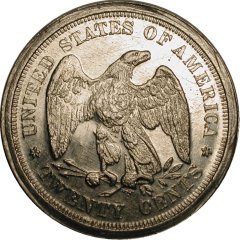8.6 Counterfeits
Circulating Counterfeits
Circulating counterfeits, also called contemporary counterfeits, are fake coins made while the imitated piece is in circulation for the purpose of fooling a merchant rather than a coin collector.
The counterfeiters only needed to create a product that looked enough like the real coin that a merchant would accept it in a transaction if they only gave it a quick glance. Some of these
counterfeits traded many times before detection.
Circulating counterfeits were most often cast in a base metal or alloy and not in silver. Such pieces are relatively crude in manufacture and appearance. Occasionally, circulating counterfeits
were struck with hand-engraved dies and are of generally high quality and able to fool most who used them for commerce.
Although common for Liberty Seated and Liberty Head (Barber) dimes, quarters, and halves, circulating counterfeits of twenty-cent pieces are rare. Since the real coins were unpopular and few people
wanted to use them, any transaction with a twenty-cent piece would ensure additional scrutiny by the recipient. Such additional attention would put the person passing the counterfeit at greater risk.
As a result, the twenty-cent piece would be a poor choice to counterfeit for commerce.
Below is a circulating counterfeit created from cast molds made from an 1875-CC BF-2 coin. The coin is made of a base metal. Circulating counterfeits of twenty-cent pieces are rare.
Click on each to see a full-size image.
 |
 |
 |
||
Circulating counterfeit 1875-CC | ||||
Numismatic Counterfeits
The example below is a counterfeit created to fool collectors, known as a numismatic counterfeit. Made in aluminum and struck from transfer dies, it is a modern creation. Although similar
in appearance to many of the counterfeits currently produced in China, a distinguishing feature of this piece is that it is struck in aluminum. Currently, the Chinese counterfeits are
struck in copper and plated in silver and as such weigh nearly the same as an authentic coin. This coin, struck in aluminum, weighs significantly less than an authentic coin. It is, however,
somewhat similar to one of the very rare twenty-cent piece pattern trial strikes, but has raised lumps, weak details, and numerous other defects. Perhaps this counterfeit was targeting
collectors of patterns.
Collectors wanting to learn more about counterfeit coin production and detection should seek the appropriate specialty resources.
 |
 |
|
Die-struck aluminum counterfeit | ||
